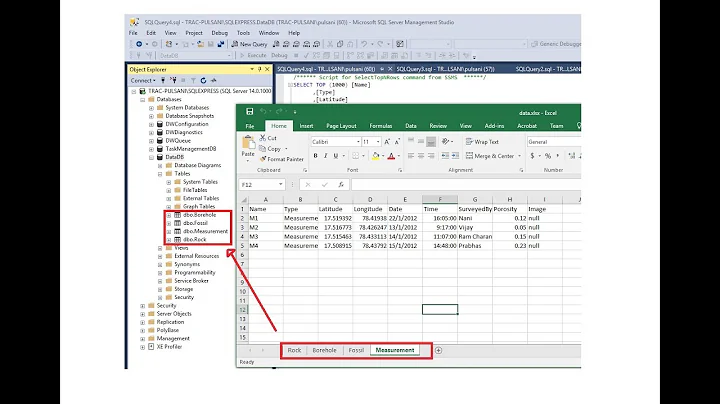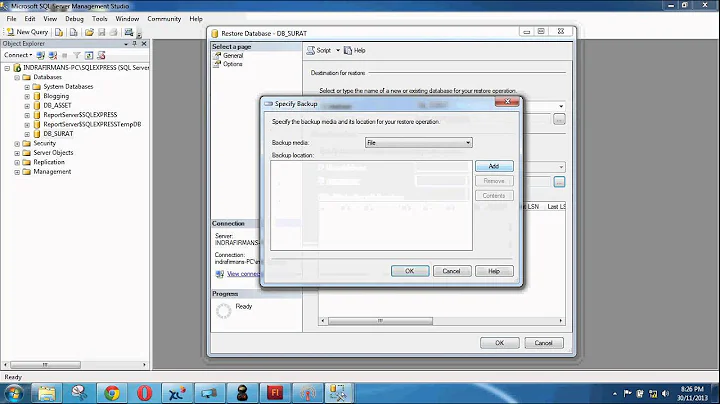Importing database from MS SQL Server 2003 to MS SQL Server 2008
First of all there is no such thing as SQL Server 2003.
You'll want to take a full backup of the source database and restore it to the new SQL Server, probably using the WITH MOVE syntax to put the files into the correct drive letter location.
Don't use the copy data or copy database wizards. They are useless.
RESTORE DATABASE [001] FROM DISK = 'C:\path\to\backup.bak' WITH REPLACE,
MOVE '001_Data' TO 'D:\Path\To\File\001.mdf',
MOVE '001_Log' TO 'E:\Path\To\File\001_log.ldf'
You'll need to figure out what the logical file names are from dbo.sysfiles on the old server and replace 001_Data and 001_Log with the correct logical file names.
Related videos on Youtube
odyd
Updated on September 18, 2022Comments
-
odyd over 1 year
I have defined this query
[query public genCascadePath(aCSharpResourceModel : CSharpResourceModel) : Sequence(Sequence(CSharpResourceModel)) = aCSharpResourceModel.hasRelatedCSharpRMManager->collect(rmm | rmm.hasRelatedCSharpRModel->asSequence()->prepend(aCSharpResourceModel)) /]What I actually do is:
get a sequence from the "aCSharpModel"
for each element in this sequence, I define it as a sequence, and prepend another element (the
rmm.hasRelatedCSharpRModelinside the collect is irrelevant, it's just a 1 to 1 relationship)
So I need something like this:
{element} -> {{element , element1},{element, element2}}But when I try to access each of the inner sequences in the result from a template, ex:
[for (path :Sequence(CSharpResourceModel) | aCSharpResourceModelManager.hasRelatedCSharpRModel.genCascadePath()) separator(' -> \n')] [/for]I get an error :
org.eclipse.acceleo.engine.AcceleoEvaluationException: Invalid type for iteration at line 18 in Module TODODbResourceRepositoryCSharpFile for block for (genCascadePath(aCSharpResourceModelManager.hasRelatedCSharpRModel)) separator(' -> '). org.eclipse.emf.ecore.impl.DynamicEObjectImpl was not an instanceof Sequence(CSharpResourceModel).
If I try to do the same for loop, but with the iterator as type
CSharpResourceModelinstead ofSequence(CSharpResourceModel), it doesn't produce an error, but it treats my query's result as a single sequence, like a flattened one.The thing is that I need to have the behavior I described at the start.
How can I achieve that?
Thank you.
-
mailq over 12 yearsSorry this is out of the scope of this site. Backup your data on the one server and restore it on the other. This is how Microsoft wants it and documented it in the Online and Offline documentation.
-
 Max over 12 yearsI did try that (see "Restore" paragraph). The exact error message I'm getting when doing so is
Max over 12 yearsI did try that (see "Restore" paragraph). The exact error message I'm getting when doing so isThe backup set holds a backup of a database other than the existing '{DBNAME}' databasealthough the name of both databases match. -
 Max over 12 yearsUpon restoring the backup I was getting the
Max over 12 yearsUpon restoring the backup I was getting theThe backup set holds a backup of a database other than the existing '{DBNAME}' databaseerror. I tried to use theOverwrite the existing database (WITH REPLACE)option which made no difference. When I try to restore the backup with a query (RESTORE DATABASE 001 FROM DISK = 'C:\path\to\backup.bak' WITH REPLACE,001being the actual db name) I get a syntax error on the database name. Could you explain in more details how you would perform the restore with theWITH MOVEplease? -
user2864202 over 12 yearsYou probably need to wrap the database in square brackets in order to get past the error. I expect you will also need to add the "with move" syntax, but one thing at a time right? RESTORE DATABASE [001] FROM DISK = 'C:\path\to\backup.bak' WITH REPLACE
-
Ryan Ferretti over 12 yearsI agree that you'll probably need the command to be "RESTORE DATABASE [001] FROM DISK = 'C:\path\to\backup.bak' WITH REPLACE" as SQL probably isn't going to like the database name starting with a number.
-
Ryan Ferretti over 12 yearsI've added syntax to my answer with how to use the WITH MOVE syntax.
-
odyd almost 9 yearsOh god, thank you very much. They should make it clear that collect flattens the result in the documentation though... Nevertheless, you solved my problem
-
Alberto Martinez over 6 yearsThat's not true, you can restore a full backup from an old version on a database created in version 2008 (I have done it with databases as old as SQL Server 2000). Restoring a full backup overwrites the database completely, no data or configuration is mixed (the only setting that can be preserved is the location of database files).
-
DeveloperChris over 6 yearsFrom what I could see it depended on how the database was created. reading other advice I first created the database in 2008. I then tried to restore over it with the replace command from a DB backed up from an old SQL 2000 instance. It failed. I then deleted the database and used the process above. it imported fine. Once I had done that I could restore with replace from the old 2000 no worries. So I believe that if you create the DB in 2008 its not compatible.
-
Alberto Martinez over 6 yearsWhen you restore from a backup of another server/database on top on an existing database, even if the other server use the same version of SQL server, you have to select the correct location of the data/log files (usually it maintains the path and file names of the original server/database) and check the option of overwrite the current database, otherwise the restore operation will fail. If you restore from backup without creating first the database you don't have to do that.
-
DeveloperChris over 6 yearsThat may be the missing step. I will try it out when I get a chance. Thank you




